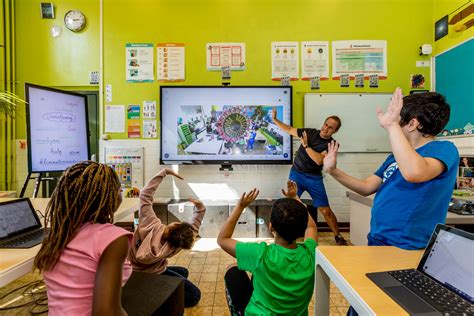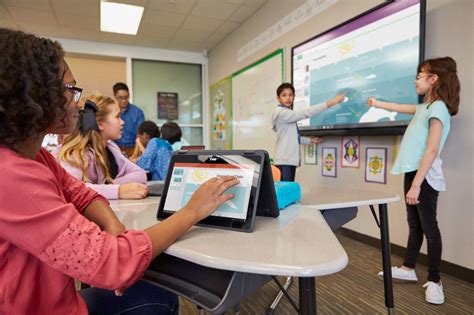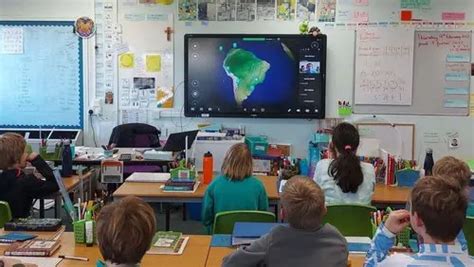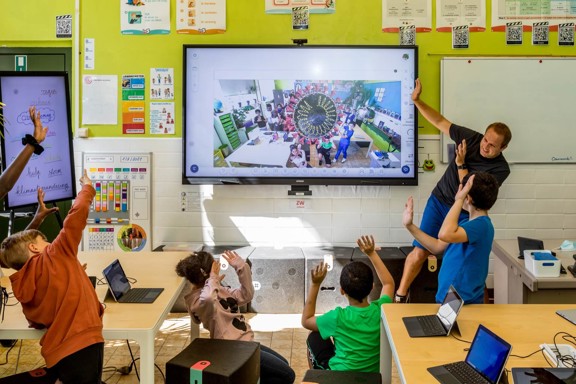In recent years, the rapid advancement of technology has profoundly reshaped the landscape of education. From interactive digital whiteboards to online learning platforms, modern classrooms are evolving to meet the needs of today’s tech-savvy students. This article explores how technology is revolutionizing education, offering both opportunities and challenges. We’ll examine current trends in educational technology, the benefits and barriers of integrating tech in classrooms, and the critical role teachers play in this dynamic environment. Through case studies, we’ll highlight successful implementations and discuss the impact on student engagement and learning outcomes. As we look to the future, understanding best practices and policy considerations will be essential for maximizing the potential of technology in education.
Join electrapk.com for an in-depth exploration of this topic.
1. Overview of Current Educational Technology Trends
Educational technology has undergone rapid advancements, revolutionizing the way students learn and teachers instruct. Key trends include the emergence of online learning platforms, which offer flexible and accessible educational opportunities that extend beyond traditional classroom boundaries. Virtual and augmented reality tools are increasingly being utilized to create immersive learning experiences, enabling students to explore complex concepts in a more engaging manner.
The educational landscape is evolving with the increasing adoption of artificial intelligence (AI) and gamification, alongside the ubiquitous use of mobile devices. AI-powered tools personalize learning experiences, automate grading, and provide real-time feedback. Gamification enhances engagement by introducing game-like elements, making learning more interactive and enjoyable. Meanwhile, the widespread availability of mobile devices empowers learners to access educational resources anytime, anywhere, fostering on-the-go learning.
Moreover, data analytics is increasingly used in education, enabling teachers to monitor student progress and adapt instruction to individual learning styles. Cloud computing is also proving essential, facilitating collaboration and resource sharing between students and teachers. Social media platforms are being incorporated into educational settings, promoting communication and collaboration beyond the traditional classroom.
The ongoing evolution of these trends is transforming education, creating more personalized, accessible, and effective learning experiences. Nevertheless, realizing their full potential necessitates a thorough examination of the challenges and opportunities they bring.

2. Benefits of Integrating Technology in the Classroom
Technology integration in the classroom provides numerous benefits that enhance the learning experience for both students and teachers. A major advantage is the ability to personalize learning. By leveraging technology, educators can tailor lessons to meet the individual needs of each student, providing a more customized approach that caters to different learning styles and paces. This individualized attention can lead to improved academic achievement.
Technology also plays a crucial role in enhancing student engagement. Interactive tools like digital simulations, educational games, and multimedia presentations bring lessons to life, making them more captivating and accessible to students. Complex subjects become easier to comprehend through these engaging methods. Furthermore, technology facilitates collaboration, enabling students to work together seamlessly on projects using cloud-based platforms and communication tools, both within and beyond the classroom walls.
Furthermore, technology equips students with crucial digital literacy skills, preparing them for the demands of today’s workforce. Teachers also reap the benefits of technology, as it streamlines administrative tasks like grading and lesson planning. This allows them to dedicate more time to delivering effective instruction and supporting their students.

3. Challenges and Barriers to Technology Adoption
Although technology integration in classrooms holds significant promise, it also faces a number of challenges and obstacles. One of the most pressing issues is the digital divide, which widens existing educational disparities. Students from disadvantaged socioeconomic backgrounds or under-resourced schools often lack access to essential technology, such as devices and reliable internet, hindering their ability to fully engage with digital learning resources.
Furthermore, the adoption of new technologies presents a substantial learning curve. Both educators and students might require extensive training to utilize these tools effectively, a process that can be time-consuming and demand significant resources. Additionally, resistance to change poses another obstacle, as some educators may be reluctant to embrace new methods due to unfamiliarity or concerns about altering traditional teaching practices.
Furthermore, the expense of purchasing and keeping educational technology current can be a significant obstacle for certain schools, resulting in outdated or inadequate resources. Overcoming these difficulties is essential to guarantee that all students can benefit from the advantages of educational technology.

4. Case Studies of Successful Tech Implementation in Schools
Successful technology implementations across different schools have revolutionized education, providing inspiring models for others. In Maine, a rural school district exemplifies this transformation with its one-to-one laptop initiative. By equipping each student with a personal device, the program fostered digital literacy, increased engagement, and boosted academic performance. Teachers leveraged the laptops to incorporate multimedia resources into their lessons, creating a more interactive and accessible learning environment.
A California school implemented a blended learning model, integrating traditional teaching methods with online instruction. This approach enabled students to learn at their own pace, with teachers serving as facilitators rather than solely as instructors. The school observed notable improvements in student outcomes, particularly in mathematics and reading comprehension.
A third instance showcases a New York school that adopted AI-powered personalized learning platforms. These platforms offered customized educational experiences, enabling students to advance at their own pace. This approach resulted in a significant rise in both student academic performance and overall satisfaction.
5. Impact of Technology on Student Engagement and Learning Outcomes
Technology’s presence in classrooms has profoundly altered how students engage and learn, often leading to remarkable changes. One prominent impact is the noticeable increase in student engagement. Interactive tools, including educational games, simulations, and multimedia presentations, breathe life into learning, making it dynamic and captivating. These tools grab students’ attention and inspire active participation in lessons. This enhanced engagement, in turn, fosters deeper understanding and helps students retain the material more effectively.
Moreover, technology facilitates personalized learning experiences, empowering students to advance at their own pace and concentrate on areas requiring improvement. This individualized approach contributes to enhanced academic achievement by catering to students’ distinct learning styles and needs.
Studies have demonstrated that schools effectively using technology often experience higher standardized test scores, especially in subjects such as mathematics and science. Moreover, technology promotes collaborative learning by facilitating student teamwork on projects and idea sharing through digital platforms. This enhances critical thinking and communication abilities. In conclusion, the thoughtful incorporation of technology can contribute to more engaged learners and improved educational outcomes.
6. Role of Teachers in a Technology-Enhanced Learning Environment
In technology-enhanced learning environments, the teacher’s role is shifting from that of a traditional instructor to a facilitator of learning. While technology offers potent tools for improving education, teachers remain indispensable in guiding and supporting students through the learning process. Their expertise is vital for selecting appropriate technological resources that align with curriculum objectives and cater to the individual needs of each student.
Teachers play a crucial role in integrating technology into their lessons in a way that maximizes its potential. This goes beyond simply using digital tools for instruction; it involves creating an environment where students can cultivate critical thinking, problem-solving, and digital literacy skills. Effective teachers guide students through the vast landscape of online resources, teaching them how to critically evaluate information and use technology responsibly.
Furthermore, teachers play a critical role in integrating technology seamlessly into traditional teaching practices. They strive to ensure that technology enhances, rather than supplants, the essential elements of personal interaction and support that are paramount to student achievement. Professional development is indispensable in this endeavor, as it empowers teachers to stay abreast of technological innovations and cutting-edge teaching methodologies.
Teachers are crucial to the success of technology-enhanced classrooms. They skillfully integrate technology to enhance learning while upholding the essential human aspects of education. These human elements are vital for student growth and development.
7. Future Predictions for Educational Technology Advancements
Educational technology is poised for continued innovation and transformation in the classroom. One anticipated advancement is the widespread adoption of artificial intelligence (AI) to personalize learning experiences further. AI has the potential to provide even more precise recommendations tailored to individual student needs, adapting in real-time to their progress and learning styles.
Augmented reality (AR) and virtual reality (VR) are poised to become increasingly commonplace, offering immersive learning experiences. By transporting students into virtual environments, these technologies allow for exploration of complex concepts and historical events. This interactive and experiential approach has the potential to significantly enhance student engagement and comprehension.
Blockchain technology could be integrated to provide secure and transparent methods for tracking academic credentials and achievements. Moreover, advancements in data analytics are likely to enable educators to gain a deeper understanding of student performance and learning patterns, thereby facilitating more targeted interventions and support.
Educational technology is poised to evolve, creating learning environments that are more personalized, immersive, and data-driven. This shift will make education more accessible, engaging, and effective for all students.
8. Best Practices for Effective Technology Integration
Successful technology integration in the classroom hinges on meticulous planning and strict adherence to best practices. Firstly, it is paramount to align technology use with specific educational goals and established curriculum standards. This ensures that digital tools serve as catalysts for learning, bolstering and enhancing learning objectives, rather than functioning as mere distractions.
Professional development is essential for teachers. It provides them with the necessary skills to effectively integrate technology into their teaching practices. Ongoing training keeps educators up-to-date on the latest tools and best practices, allowing them to fully leverage the benefits of technology in the classroom.
Moreover, choosing user-friendly and dependable technologies is crucial to prevent technical problems that can hinder learning. Schools must also guarantee equitable access to technology for all students to avoid disparities in educational opportunities.
Using digital platforms to encourage collaboration and communication among students can enrich their learning experiences and cultivate teamwork skills. Regularly evaluating the impact of technology on student outcomes is crucial to identifying areas for improvement and ensuring that technology remains a valuable tool in the educational process.
Schools can effectively integrate technology and foster a more engaging and productive learning environment by adhering to these best practices.
9. Policy and Funding Considerations for Educational Technology
For educational technology to be successfully integrated, policy and funding decisions are paramount. Effective policies must prioritize equitable access to technology, guaranteeing that all students, regardless of their socioeconomic status, have the resources they need. This includes not only supplying devices but also ensuring reliable internet access.
Technology acquisition and maintenance hinge on securing adequate funding. To meet these costs, schools must pursue a variety of funding sources, such as government grants, private partnerships, and community support. This funding will cover technology purchases, staff training, and ongoing maintenance. Strategic budgeting plays a crucial role in prioritizing expenditures that align with educational goals, ensuring maximum impact.
Furthermore, policies should incorporate provisions for routine technology updates and repairs, guaranteeing that tools remain contemporary and operational. Schools must also establish clear guidelines for the responsible use of technology, encompassing issues like data privacy and cybersecurity to safeguard both students and educational institutions. Robust policy and funding strategies are essential for fostering a sustainable and effective learning environment.
In conclusion, the integration of technology in education offers transformative benefits, enhancing student engagement and learning outcomes while presenting unique challenges. By understanding current trends, overcoming barriers, and implementing best practices, educators can leverage technology to create dynamic and personalized learning experiences. Looking ahead, advancements in AI, AR, and data analytics promise even greater possibilities for education. Effective policy and funding strategies are essential to support these innovations and ensure equitable access. Embracing these changes thoughtfully will pave the way for a more effective and inclusive educational landscape.
electrapk.com
